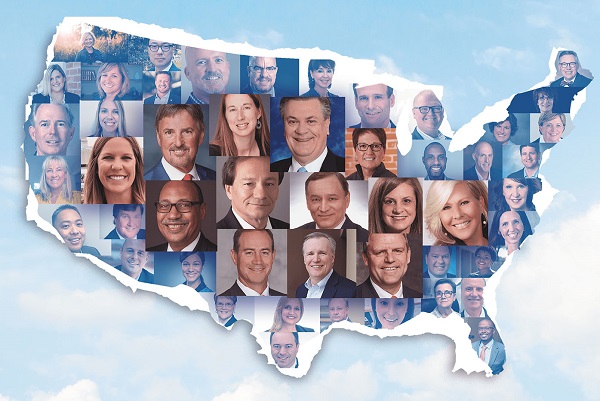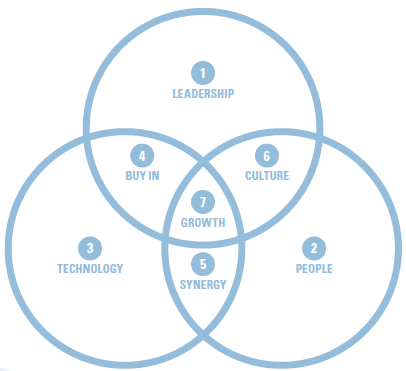This Year’s Model

By: Will Jones
Whatever you want to call 2020—the year of the pandemic, the great pause, an absolute dumpster fire—it was a hard year.
At the onset of the pandemic, Yelp.com reported that around 140,000 businesses were temporarily shuttered. By August that had fallen to 65,000. That drop, however, did not represent a grand reopening of the economy. Instead, Yelp.com’s September Local Economic Impact Report showed that around 100,000 businesses were gone for good, a 23% increase from July 10.
While restaurants and retail bore the brunt of the economic downturn, certain sectors showed resilience. “Yelp closure data shows that businesses providing home, local and professional services have been able to withstand the effects of the pandemic particularly well,” according to the Yelp.com report.
However, nearly 50% of Big “I” members reported decreased revenue for the year and 46% said they lost commercial clients during the pandemic, according to a Big “I” survey, which also found that approximately 70% of agencies received a Paycheck Protection Program (PPP) loan or other financial assistance during the pandemic.
The pandemic has changed the nation’s attitude toward risk. What was once deemed unthinkable now seems possible. This year, independent insurance agencies are uniquely positioned to help clients assess and mitigate their exposure. However, the results from the Big “I” study show that agency owners aren’t immune to economic pressure and must adapt. With the right approach, adaptation will lead to more than just survival.
“As we go into 2021, we need to not only think in different ways but act in different ways,” says Jon Jensen, Big “I” chairman and president & CEO of Correll Insurance Group in Spartanburg, South Carolina. “People need independent agents now more than ever, because when there are uncertainties in the economy, businesses must make sure that the protection they need is in place.”
As illustrated by the Venn diagram below, leaders from across the Big “I” talk us through a paradigm for guiding your agency into the brave new world.
 1) Leadership
1) Leadership
The crises in 2020 meant that strong leadership was essential. Leadership in navigating new challenges, reacting to pivoting business modes, outlining a short-term plan and communicating with colleagues in unfamiliar circumstances with a sense of reassurance all became aspects of the average agency leader’s job description.
In 2021, the necessity to make tough decisions and pivot to meet pandemic-related changes is likely to continue. For leaders, that means “setting the vision, the mission and the goals for the business and making sure that you’re executing on that,” says Bob Fee, president of Fee Insurance in Hutchinson, Kansas, and Big “I” chairman-elect.
“You’re always on a mission,” he continues. “The mission may change a little bit or need to be refined. But as long as you’ve got your people on board with where you’re headed, they can help you get there.”
While many of the hallmarks of great leadership are synonymous with both times of turmoil and normalcy, 2021 will undoubtedly call for certain traits in spades.
“Leadership begins with asking a lot of questions, listening and trying to understand the situation,” Fee says. “At the same time, it’s about leading by example. Leaders live up to the standards that they expect everyone else to live up to.”
“Good leaders are accessible and consistent,” he adds. “They get a lot of credit when credit is due, but they accept the responsibility when anything bad happens.”
2) People
The most valuable aspect of any business is its people. However, events in 2020, namely the pandemic, physically divided us. With the effects of COVID-19 likely to linger in the new year, independent agencies must connect with clients on a human level as well as a business one—which shouldn’t be too difficult given that the majority of Americans are going through the same traumatic experience.
“We work in an industry where people call us when they’ve had something tragic happen to them but in a lot of cases, we have not experienced it ourselves,” Jensen explains. “But with everything that’s going on in the world right now, it’s affecting every single one of us in one way or another—we’re all bonding together and that’s helping us support our clients.”
In December, unemployment stood at 6.7%, according to the U.S. Department of Labor. As the insurance industry prepares to replace retiring experienced producers, those stark figures provide agencies with an opening to hire the next generation of intelligent, hard-working and empathetic people they need to compete and grow in a hardening market. Jensen urges hiring managers to look beyond industry experience and seek aptitude and attitude.
“There are opportunities to hire some great folks that find themselves unemployed, so let’s open our minds to those that are applying for jobs,” he says. “Let’s not just look for experience, let’s look for character, personality traits and other attributes that could make them a good fit for the service and sales industry that we’re in.”
And while working remotely can make it harder to effectively lead a team, “we’ve got to respond to those things,” Jensen says. “We have to guide our teams through this time emotionally, but we also have to trust them to put their best foot forward and do the right things for their clients.”
“Just because we can’t see somebody sitting at their desk doesn’t mean we should doubt what they’re doing or that they’re going to make the best decisions,” he adds.
3) Technology
As fast as COVID-19 swept across the country, rapid and forced technology adoption swept across the independent agency channel. Now, the question on everyone’s lips is: How much of this technology is going to stick around for the long haul?
Cindy Hower, owner of Kellerman Insurance in Holton, Kansas, and Agents Council for Technology Committee chair, predicts that independent agents are “going to take the best of what we’ve learned out of 2020 into the future,” but warns that “completely eliminating in-person contact is not necessarily the best course of action.”
Servicing clients virtually and working from remote locations wasn’t without its teething problems. But for many agencies, their biggest worry was the solvency of their clients and, as a result, their book of business.
As businesses remain in relative inertia and homeowners prudently plan their personal finances against the backdrop of a harsh economic climate, agencies should turn to the information held within their AMS for opportunities to demonstrate why they are their clients’ trusted adviser.
“We are looking for opportunities within our book to cross-sell, introduce our customers to new and additional endorsements, and increase their liability limits,” says Angela Ripley, president of VW Brown Insurance Service in Columbia, Maryland, and the most recently elected member to the Big “I” Executive Committee.
“In March, we started reaching out to people with regard to working from home, their commute and other aspects of their situations.” When carriers returned premiums to insureds, “it was another opportunity for us to talk with them,” she says.
When thinking about investing in technology to uncover new opportunities, increase retention and improve service, Ripley encourages agencies to “embrace every opportunity,” but urges agencies to “take the time to research how they could benefit your agency.”
Another reason not to rush into technological upgrades is that, like every business in the post-COVID-19 world, technology is adapting too. “A year from now, products are going to look very different because carriers and vendors are out there creating new services to streamline your agency,” Hower says. “If you’ve considered a product today, it’s going to be worth checking it out a year from now because I bet it won’t look the same.”
4) Buy In
Making big technological changes at your agency is a difficult task. Further, making changes without it affecting productivity is akin to trying to make an oil change while going 100mph along the freeway.
For agency leaders who encounter pushback, there are a few approaches to ease the process. “You’ve got to talk about it because you can’t let it become a division in the agency,” Hower says. “It can be a tough situation if one group isn’t willing to embrace it.”
To keep the equilibrium, “you need to make sure that you’re giving the right people the right seat on the bus by making sure that those that can operate the technology excel at it, which will keep your agency moving forward,” Hower adds.
“The right seat on the bus” is a concept developed in the book “Good to Great: Why Some Companies Make the Leap…and Others Don’t” by James C. Collins. Those who build great organizations make sure they have the right people on the bus and the right people in the key seats before they figure out where to drive the bus. In a multigenerational workplace where staff age could range between 22 and 72, the concept is an ideal outlook for technology adoption at independent agencies.
“In our agency, I try to give each generation the tools to communicate in the manner that they prefer. I like to do that with our clients too,” says Jana Foster, owner of Nevada Insurance Agency Company in Carson City, Nevada, and chair of the Big “I” National Young Agents Committee. “If you can understand the digital habits of your employees and respect them, that’s the key to managing the generational gap.”
Additionally, “if every employee can recognize that it’s easy to get one piece of information over a chat platform, but something more in-depth is going to require a longer phone, video or in-person conversation, I think we can be more successful in our business,” Foster says. “We have to be flexible about the technologies our clients and employees are craving, regardless of their generation.”
5) Synergy
While technology has at times been seen as a threat to the independent insurance agency channel, 2020 made it clear that technology is a friend, not a foe. Technology is not threatening independent agencies with extinction, it is improving them by making their business and their people more efficient, facilitating connections with clients anywhere in the country, reducing the amount of busywork and providing opportunities to monitor performance.
“We’re using technology to simplify small, repetitive tasks to give our employees back the ultimate resource—more time—so they can utilize that time for the more important items on their desk,” Foster says. “We’ve been having conversations this year about working smarter, not harder.”
On the management side of the equation, agencies can employ technology to monitor employee production by assessing not just how much they’re producing but, more importantly, the process they are using to produce.
Ripley’s agency uses a VoIP phone system that is integrated within its agency management system. “On the dashboard, I can see who’s on the telephone, I can listen in on our staff talking with our customers, and then I go back and make suggestions on ways to talk to customers,” she says. “We installed that in 2019 and it was beneficial when we switched to remote work in March.”
The pandemic made businesses more open to remote work and digital capabilities, but millennials and Generation Z were already at the forefront of technology and innovations. While investing in and implementing technology is sometimes expensive and arduous, “for what you invest, you’ll absolutely get many times over in return from younger professionals,” Foster says. “You’ll attract these digital natives and, if you use those tools correctly, you can retain that talent too.”
While using technology can be seen as a trade-off between efficiency and relationships, that isn’t necessarily the case for digital natives. “That generation has somehow mastered developing online relationships,” Foster says.
“In this industry, relationships matter—they are the backbone of the independent model,” she adds. “If you employ a member of the younger generation who is able to establish a strong client relationship without even picking up the phone, that is a win.”
Further, as the American workforce becomes more comfortable with remote work, geographical restraints to hiring are fading. “Remote work has opened up the entire world. Employers should no longer be afraid to look past the fact that they’re not going to be in the office,” says Bennie Jones, president of Risk Management Solutions of America, Inc. in Chicago, and chair of the Big “I” Diversity Council.
6) Culture
Last year, a pandemic, social unrest and a bitter election battle divided Americans physically and socially. In the workplace, that meant strong and clear leadership was essential to usher teams over the many business barriers the tense environment created. However, a strong business culture means that a leader’s job is made much easier.
“The key to creating a strong culture is always making sure that everyone’s opinion has at least been heard, that it’s encouraged that everybody shares, and that everyone knows that you value their opinion,” Jones says, who revels in the mantra that, “if you’re a leader and you embrace the new normal, you get an opportunity to help shape it.”
Before the pandemic, Jones used to take everybody in the office on walks and intentionally pair two staff members—such as an older and a younger staff member—to “encourage an interchange of ideas” and “promote exploration and understanding of different aspects of the company and the industry,” he says.
The culture at Jones’ agency means that “we have good retention,” he explains. “One of the things I try and do is make certain that everyone is aware of our vision—and then make very certain that they understand how they fit into it.”
In 2021, Jones recommends using the vision of your agency not only to set your business on the right course but to retain millennial and Gen Z employees, “who typically tend to stick around for about three years,” he says. “That isn’t necessarily because they’re dissatisfied with the company; it’s simply that they get bored doing the same thing and want to create something new.”
“If agency owners can show these employees a career path and help them to recognize how to be promoted, they will have a better understanding of how they fit into that vision not only today, but how they would fit in tomorrow,” he adds.
Just as hiring workers to work remotely can benefit your agency, hiring workers from diverse backgrounds can too. Companies with higher gender diversity on executive teams are 21% more likely to outperform others on profitability and 27% more likely to have superior value creation, according to McKinsey. Companies with higher ethnic and cultural diversity on executive teams were 33% more likely to have industry-leading profitability.
While Jones encourages more diversity and inclusion in hiring practices, “you have to understand or be willing to accept diverse cultures as well,” he says. “If I ask someone to just simply come in and absorb my culture but I’m not even willing to look at theirs, I’m never going to get their full potential as an employee.”
7) Growth
While many will be relieved that 2020 is finally over, businesses are still approaching 2021 with trepidation. “A lot of folks are scared about what will happen and if businesses will recover,” Jensen says. “It may be slow in some areas, but they will recover. We’re all dealing with this situation together and we’re bullish on where the industry is going.”
In the post-COVID-19 economy, hiring from a broader talent pool—both demographically and geographically—will improve agencies’ perpetuation strategy and bring new ideas into a hybrid in-person and virtual office environment. Agencies that adopt technology can harness the full force of existing and emerging innovation to work more effectively and ultimately gain the opportunity to solve many of the insurance industry’s pain points.
Agencies looking to grow must “set their course,” Fee says, and focus on “getting the right people on board and committed to the effort. Then invest in technology that’s going to get you there more efficiently.”
“We’ve had to think about how we get people to work from home, how we hire more younger people, and how we put the technology behind those things,” Jensen says. “2020 is a good catalyst for some of the things we should have been doing to some degree. Now it’s time for agents to really act on these things.”
Will Jones is IA editor-in-chief.
On the coverCentral image, clockwise from far right: Karen O’Connor Corrigan, Big “I” Technical Affairs Committee chair; Todd Jackson, Big “I” Executive Committee member; Mike McBride, Big “I” Executive Committee member; Bob Fee, Big “I” Executive Committee chair-elect; Bennie Jones, Big “I” Diversity Council chair; Jana Foster, Big “I” National Young Agents Committee chair; John Costello, Big “I” Executive Committee member; Lindsey Shank, Invest Board chair; Lou Moran, Big “I” Executive Committee member; Cindy Hower, Agents Council for Technology Committee chair; Angela Ripley, Big “I” Executive Committee member; Bob Rusbuldt, Big “I” president & CEO; Jon Jensen, Big “I” Executive Committee chair. Also pictured: Ann Watkins, Independent Insurance Agents and Brokers of Idaho national director; Andrew Chong, Big “I” Diversity Council member; Brad Wilson, Independent Insurance Agents and Brokers of California national director; Bobby Salmon, InsurPac Board of Trustees chair; Cynthia Cabaza, Big “I” Diversity Council member; Charles Symington, Big “I” senior vice president of external, industry, and government affairs; Jared Blackwood, Big “I” National Young Agents Committee member; Diana Hornung Hanby, The Insurance Agents & Brokers national director; Cynthia Webster, Big “I” Diversity Council member; Deb Schilz, Independent Insurance Agents of Nebraska national director; David Walker, Trusted Choice® Board chair; Tyra Dressel, Big “I” Oregon executive director; Deborah Pickford, Invest executive director; Kyle Ulrich, Florida Association of Insurance Agents president & CEO; Mel Evans, Big “I” Diversity Council member; Ron Berg, Agents Council for Technology executive director; Jesse Konold, Big “I” National Young Agents Committee member; Ashley Brady, Big “I” Government Affairs Committee chair; Aimee Pineiro, Big I Advantage® vice president; Denise Johnson, Independent Insurance Agents of Oklahoma president and CEO; Beth Montgomery, Big “I” vice president, company relations; Kasey Connors, Trusted Choice® vice president of marketing operations; Brandon Okita, Big “I” Diversity Council member; Shaw Johnson III, Big “I” Mississippi national director; Chris Boggs, Big “I” executive director, risk management and education; Toni Jones, Big “I” National Young Agents Committee member; Kevin Brandt, Trusted Choice® executive director; Whitnee Dillard, Big “I” Diversity and Inclusion director; Tina Olson, Independent Insurance Agents of North Dakota national board director; Susan Nester, Big “I” vice president, communications; Ross Johnson, Independent Insurance Agents of West Virginia national director; Cassandra Koegel, Big “I” National Young Agents Committee member; Madelyn Flannagan, Big “I” vice president, agent development, education and research; Mark Wolf, Big I Advantage® president; Nathan Riedel, Big “I” vice president, political affairs; Quincy Branch, Federal Advisory Committee on Insurance member. |










